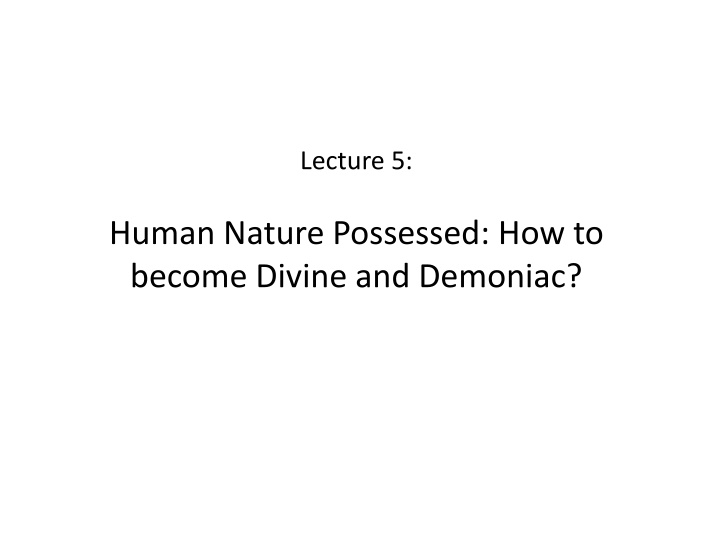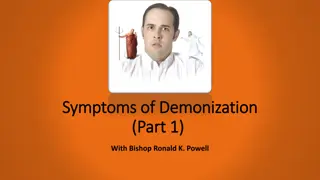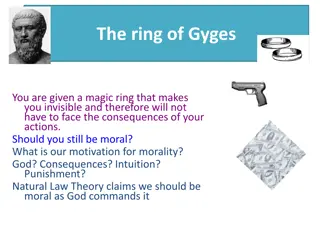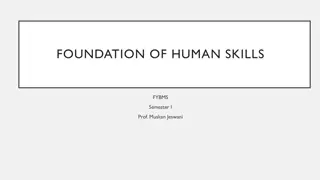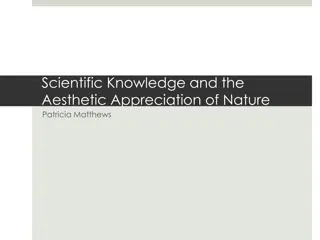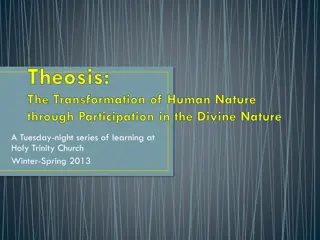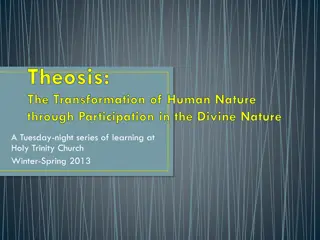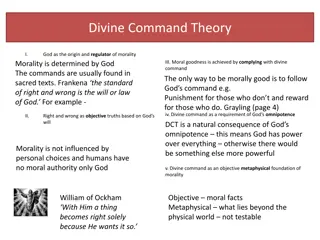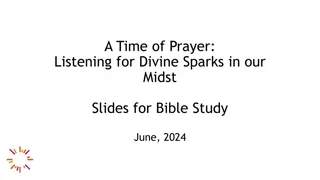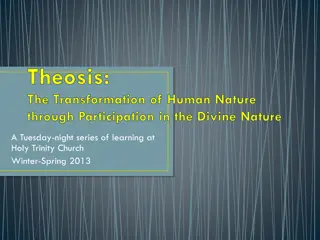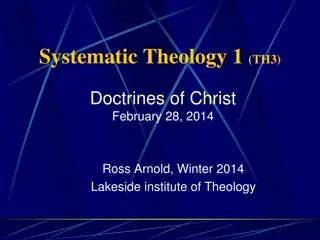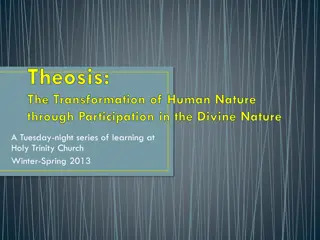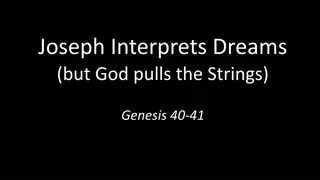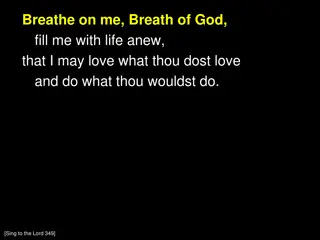Human Nature Possessed: Becoming Divine and Demoniac
This lecture delves into the fascinating concept of spiritus, the subtle vapour believed to be the source of vitality in the body. Exploring the three forms of spirit and its intricate connection to the soul and bodily functions, it illuminates how individuals can attain divine or demoniac qualities. The imagery of S. Clare of Montefalco receiving the cross symbolizes spiritual transformation, while relics and canonization highlight the veneration of saints. Discover the profound depths of human nature and the path to spiritual elevation in this thought-provoking discourse.
Download Presentation

Please find below an Image/Link to download the presentation.
The content on the website is provided AS IS for your information and personal use only. It may not be sold, licensed, or shared on other websites without obtaining consent from the author.If you encounter any issues during the download, it is possible that the publisher has removed the file from their server.
You are allowed to download the files provided on this website for personal or commercial use, subject to the condition that they are used lawfully. All files are the property of their respective owners.
The content on the website is provided AS IS for your information and personal use only. It may not be sold, licensed, or shared on other websites without obtaining consent from the author.
E N D
Presentation Transcript
Lecture 5: Human Nature Possessed: How to become Divine and Demoniac?
Spiritus: a subtle vapour produced in the blood and disseminated throughout the body by the arteries and nerves. It was considered to be the central source of activity in the living body. Three forms: 1. natural spirit: resided in the liver, the center of nutrition and metabolism 2. vital spirit was located in the heart, the center of blood flow regulation and body temperature, 3. animal spirit was animal spirit was created in the brain, the center of sensory perceptions and movement.
The soul being united to bodily substance useth the spirite: which is the most universall instrumente of the soul the soul directeth it, and guideth it vnto more particular instruments, for more speciall and priuate vses, as to the eye, to see with; to the eare to heare; to the nose to smell; to the bowells, stomack, and liuer, to nourish, to the heart, to maintaine life: and to other partes, to the end of propagation: this is all performed by the selfe same, one, and single spirite. I know commonly there are accompted three spirits: animall, vitall, and naturall Timothie Bright, A Treatise of Melancholy with the Physicke Cure (1586), 46-7.
S. Clare of Montefalco receiving the cross with Christ literally implanting his cross into her heart. (church of Santa Chiara, Italy)
Relic: usually consists of the physical remains of a saint or the personal effects of the saint or venerated person preserved for purposes of veneration as a tangible memorial. Miracles and marvels are attributed to such relics until today (e.g. Lourdes) Detail from reliquary cross containing the crucifix, scourge and the three gallstones in Clare s corpse in 1308, Montefalco held at the Church of Santa Chiara
Canonization: the process by which Orthodox, Roman Catholic, or Anglican Church declares that a person who has died was a saint. Upon this declaration the person is included in the canon, or list, of recognized saints. Stages of canonization in the Catholic Church (since 1983) Servant of God Venerable Blessed (beatification) Saint (cannonisation) To be canonized a saint, the person in question (in the state of the Blessed ) must have performed at least two through the his/her intercession after his or her death (i.e., an additional miracle after that granting beatification).
Aristotle and the Soul Aristotelian psychology: the study of the soul or psyche (in his text, De Anima); the study of the nature of the soul (or psyche), which he considered the basis of all life. The soul, according to Aristotle, is the essence of all living things that makes them behave in the ways distinctive of living things. note:today the term psychology refers only to the study of the mind; Aristotle understood it in a much broader way Central question for Aristotle was: How does the soul relate to the physical body? Answer: He regards the body as the matter (parts and material that make up the body) and the soul as the form of a living thing. The two are correlative to one another. What humans do involves always the soul and the body together (differs from Plato s ideas of the soul).
Aristotle subdivides the soul into three kinds: vegetative/nutritive soul: was the lowest soul which included the functions basic to all living things: nutrition, growth and reproduction. sensitive soul: second highest of the three souls which included all of the powers of the vegetative soul as well as the powers of movement and emotion as well as the ten internal and external senses. Intellective/rational soul: included not only the vegetative and sensitive powers the organic faculties of the other two souls - but also the three rational powers of intellect, intellective memory (memory of concepts, as opposed to mere sense images) and will.
All living beings/things were divided into genera according to the kind of soul they possessed according to Aristotle (hierarchy of souls) 1. Plants only possess the vegetative or nutritive soul 2. Imperfect animals (including sponges, worms and bivalves) partial sensitive soul Perfect animals (including insects, birds and mammals) a complete sensitive soul But they also possess the vegetative/nutritive soul 3. Humans beings only living beings with or rational soul (but humans also possess the other two souls vegetative and sensitive ) intellective
Soul is not thought to be material but is nevertheless related to specific organs in human body: 1. Vegetative powers of vegetative / nutritive soul : located in liver, served by the veins and auxiliary members such as the bladder and genitals. 2. Emotive powers of sensitive soul : located in the heart, served by the arteries 3. Power of cognition and voluntary motion of intellective / rational soul : located in the brain, served by the nerves, the sense organs, and the muscles
Souls and the organs where they were believed to reside relied for the operation on spirits - goes back to medical ideas of Galen spirit/pneuma:means air or breath , and is imagined as a sort of hot vapor fused in blood 1. natural spirit: resided in the liver, the center of nutrition and metabolism. 2. vital spirit was located in the heart, the center of blood flow regulation, heart beat, respiration, and body temperature. 3. animal spirit was created in the brain, the center of sensory perceptions and movement. Galen s idea of body and spirits
The production of Galens spirits: 1. The chyle, or digested food, is brought to the liver, where it is worked up into an impure blood, imbued with the first form of spirit innate to all things, the natural spirit. This concoction passes into the veins, which are believed to leave from the liver. This blood, charged with natural spirit, then goes to the right chamber of the heart, where impurities are exhaled through the lungs. The purified part then trickles through the invisible pores of the inter- ventricular septum to the left ventricle, entering it drop by drop. (note: these invisible pores do not exist according to today s knowledge!) There, the blood is imbued with more spirit, drawn from the outside by inhalation through the lungs. The net result is that the blood is now charged with a higher form of spirit, the vital spirit. This blood, along with its associated natural spirits, goes via the arteries issuing from the heart to the brain, in particular, the fine net of arteries at the base of the brain, the reta mirabile. There the blood is further refined and charged with the final and highest form of spirit, the animal spirit. The animal spirit pass through the solid part of the brain and the ventricles of the brain and then to the nerves, which are hollow tubes. It is through the agency of the animal spirit that movement and thought are affected. 2. 3. 4. Liver: transforms the cooked food (chyle) into impure blood and imbuing it with the first form of spirit, the natural spirit Heart: purifying the blood and charging it with the second form of pneuma, the vital spirit Brain:works up the highest form of pneuma, the animal spirit. 5. 6. Note: Galen did not attach any theological or philosophical meaning attached to his system of spirits!
During 12-14thcentury the spirit took on theological meanings Appropriation of natural function and organs related to the spiritual and soul systems of Galen and Aristotle and the linking of these physiological ideas to Christian ideas, expressed in the Bible and writings of Church fathers Devil snatches the spirit leaving the body of dying man through the mouth (Danish mural, 12th century)
Def. exorcism: the practice of evicting demons or other spiritual entities from a person believed to be possessed.
Let us no one have any doubt that demons are in the body, not the soul. Only God, not a created thing, can enter into the human soul through the inhabitation of grace. (Thomas of Cantimpre, in Caciola, p. 283) Demons can disrupt human senses and sense communication
Discerning Holy and Demonic Spirits The responses of an audience to a mystic s public performances were intricately bound up with the question of how external behaviors were thought to mirror internal, spiritual states. This process of discerning spirits became a major hermeneutic challenge. One would have to establish a truth about the encounter, a truth about the interior movements within the soul, and a truth about the somatic signs of the body. Discerning a spiritual possession was also a social practice involving processes of negotiation between ordinary men and women as well as attendant clergymen and medics.
How to approach this subject as historians? The beliefs and case studies reviewed in this lecture would have once been used to illustrate past ignorance and superstition. Is the assumption of ignorance a helpful starting point? It is more fruitful to try and comprehend what made certain beliefs possible, rational and truthful at particular moments in time. The belief in demonic possession fitted into a coherent system of Aristotelian natural philosophy. Whilst God could intervene supernaturally in human affairs that is, work above and beyond the realm of nature and touch the soul the devil and demonic spirits worked through preternatural forces and were conceptualised as part of early modern nature. Therefore their effects on human beings were, of necessity, a part of early modern science and medicine. (see Stuart Clarke s Thinking with Demons).
